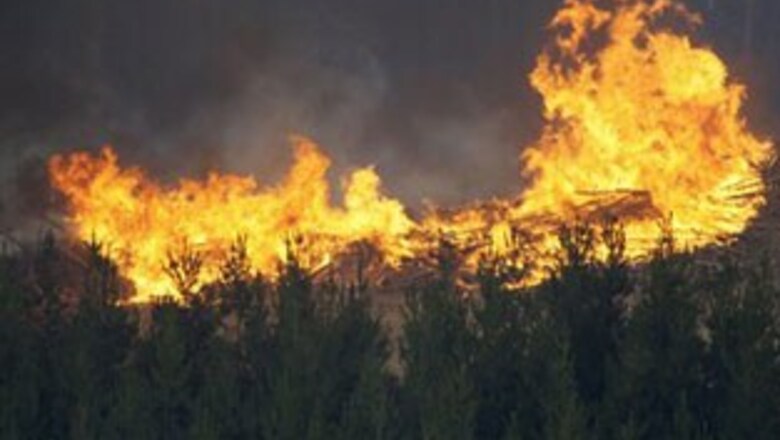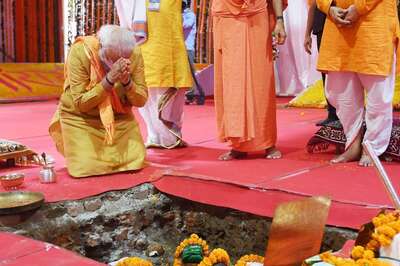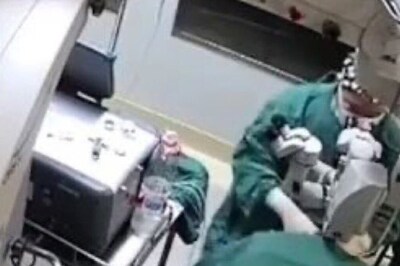
views
Whittlesea: Suspicions that the worst wildfires ever to strike Australia were deliberately set led police to declare crime scenes Monday in towns incinerated by blazes, while investigators moving into the charred landscape discovered more bodies.
The death toll stood at 130.
Officials believe arson may be behind at least some of the more than 400 fires that tore a destructive path across a vast swath of southern Victoria state over the weekend. Prime Minister Kevin Rudd, visibly upset during a television interview, reflected national disgust at the idea.
"What do you say about anyone like that?" Rudd said. "There's no words to describe it, other than it's mass murder."
Police have sealed off at least two towns — Marysville and Kinglake — where dozens of deaths occurred — setting up roadside checkpoints and controlling access to the area.
Victoria Police Commissioner Christine Nixon said specialist fire investigators were on the ground at one fire site, in Churchill, east of Melbourne, and would go to others.
Kinglake is "where the most deaths are, but wherever a death has occurred we investigate that as a crime," Nixon told Australian Broadcasting Corp. radio.
Anyone found guilty of lighting a wildfire that causes death faces 25 years in prison in Victoria. However, a murder conviction could result in a life sentence, said federal Attorney General Robert McClelland.
At least 750 homes were destroyed. Officials said both the tolls of human life and property would almost certainly rise.
Stunned survivors were gathering at dozens of emergency relief centers at town halls and schools.
At the town of Whittlesea, 7 miles (12 kilometers) west of the Kinglake region, survivors sat in the dirt outside, accepting cups of coffee and sandwiches being handed out by volunteers. Others hugged each other with tears in their eyes.
Australian Red Cross officials were compiling lists of survivors to make it easy for family members to track them down.
The Red Cross said more than 4,000 people had been listed across the state.
Jack Barber said he fled his house in Pheasant Creek with his wife and a few belongings on Saturday and spent the night on a sports field dodging flames that licked at them from different directions as wind gusts blew them closer.
They drove out of the disaster zone on Sunday.
"There were dead horses, live horses, kangaroos bouncing down the road with flames at their back. It was horrific," Barber said.
Victoria state Premier John Brumby on Monday announced a royal commission would be held. A royal commission is among the highest-level investigations that can be called under Australian law.
Usually, a former judge is appointed to take extensive evidence and make formal findings that can lead to charges or changes in the law.
While weather conditions have eased since Saturday's inferno, more than one dozen fires still burned in Victoria and gusting winds threatened to fan them toward towns not previously hit.
Forecasters said temperatures may rise again later in the week.
Blazes have been burning for weeks in the southeastern state of Victoria but turned deadly Saturday when searing temperatures and wind blasts created a firestorm that swept across the region.
A long-running drought in the south — the worst in a century — had left forests extra dry and Saturday's fire conditions were said to be the worst ever in Australia.
From the air, the landscape was blackened as far as the eye could see. Entire forests were reduced to leafless, charred trunks, farmland to ashes. The Victoria Country Fire Service said some 850 square miles (2,200 kilometers) were burned out.
Only five houses were left standing out of about 40 in one neighborhood of the hard-hit Kinglake district that an Associated Press news crew flew over.
Street after street was lined by smoldering wrecks of homes, roofs collapsed inward, iron roof sheets twisted from the heat.
The burned-out hulks of cars dotted roads. A church was smoldering, only one wall with a giant cross etched in it remained standing.
Residents were repeatedly advised on radio and television announcements to initiate their so-called "fire plan" — whether it be staying in their homes to battle the flames or to evacuate before the roads became too dangerous. But some of the deaths were people who were apparently caught by the fire as they fled in their cars or killed when charred tree limbs fell on their vehicles.

















Comments
0 comment